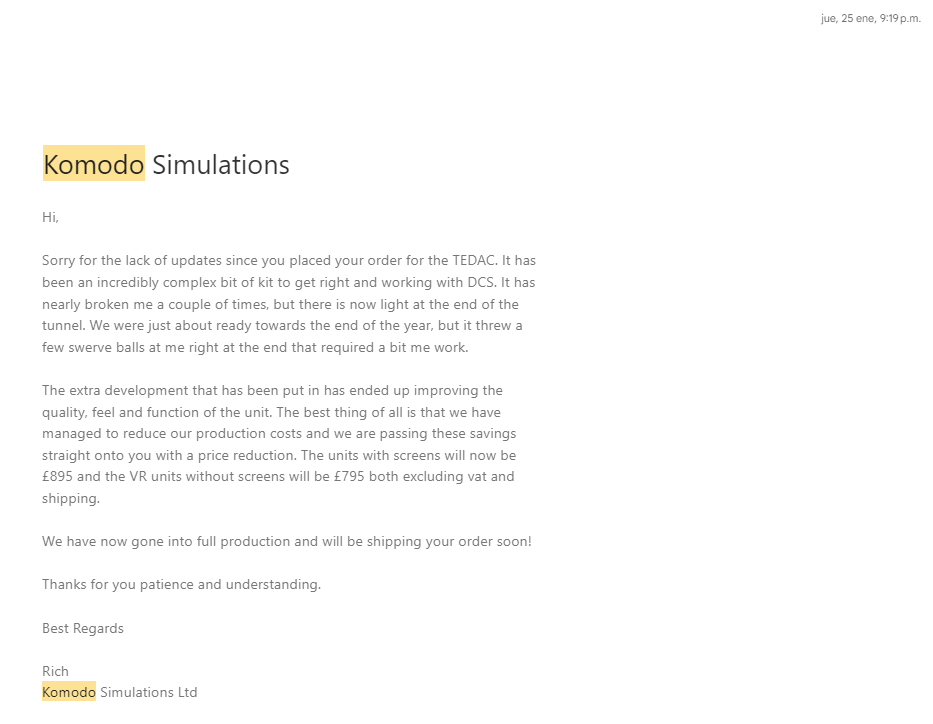-
Posts
48 -
Joined
-
Last visited
About patogn20
- Birthday 10/16/1989
Personal Information
-
Flight Simulators
DCS (AH64/UH1H/F16)
-
Location
Argentina
Recent Profile Visitors
The recent visitors block is disabled and is not being shown to other users.
-
patogn20 started following DON'T BUY FROM KOMODO! SCAMMERS
-
I bought a Komodo Simulations TEDAC on 27Dec23 It said it was supposed to have a 12-16 week delivery time. I actually think its a lot, but since it looked really nice and there were no TEDACs available in the market, I decided to go with it. null25Jan24 i received a mail which i considered a bad joke, telling me as good news that i payed 1.150GBP for a unit that now costed 895. I asked if they were going to compensate for that in some way. No answer from them. After waiting for more than 2 months without any sign of life from the shop, i decided to send them an email, obviously without any reply, 2 weeks from now. Awful customer support. While checking on the website to gather some aditional info to write this as accurate as possible, i see that they extended the delivery time to 12-20 weeks, but anyway they are already late, almost reaching 22 weeks from the date of purchase. You can have some delay in your shippings. What i cannot understand is that you don't inform your customers, specially those that payed a huge amount of money for something. No update on the purchase, no answering mails. I won't buy from them again in my life, and i hope you don't also. I just hope to get my money back. null
-
- 1
-

-
Awesome work! I'm not a G fan, but this is great! Keep up the good work. The best part was that you guys are planning more modern cobras! Discord Link: https://discord.gg/HsW8BdUCr8
-
patogn20 changed their profile photo
-
Forgot to add that when using the nano directly to the pc (not RS485) the panel works perfectly! Using latest open beta and latest DCS bios version(0.10.0)
-
Hi all!! I'm making some really good progress with my cockpit. Been able to run a full panel with no problem. Now, i added a second panel (caution lights). I'm able to extract information ok. Both panels work when connected to the same RS485 network. Problem is that lights tend to go off and on randomly, after a couple of seconds. Thought it was a power supply problem, but although sending mega's 5V through VIN and connecting the nano to the PC, it keeps doing that. I'm running 17 leds in each pinout of the nano, leaving D2 for the MAX487 chip. As i'm writing this, i quit DCS with the panel on and the lights that were supposed to be on after aircraft shutdown are permanently on, so i guess it isnt a power problem. Looks like there's a comms problem between DCS Bios and my panel. Here's the Caution Panel sketch i'm using right now /* The following #define tells DCS-BIOS that this is a RS-485 slave device. It also sets the address of this slave device. The slave address should be between 1 and 126 and must be unique among all devices on the same bus. */ #define DCSBIOS_RS485_SLAVE 122 /* The Arduino pin that is connected to the /RE and DE pins on the RS-485 transceiver. */ #define TXENABLE_PIN 2 #include "DcsBios.h" /* paste code snippets from the reference documentation here */ DcsBios::LED clB1(0x1414, 0x0800, 3); DcsBios::LED clC1(0x1414, 0x1000, 4); DcsBios::LED clD1(0x1414, 0x2000, 5); DcsBios::LED clE1(0x1414, 0x4000, 6); DcsBios::LED clF1(0x1414, 0x8000, 7); DcsBios::LED clG1(0x1416, 0x0001, 8); DcsBios::LED clH1(0x1416, 0x0002, 9); DcsBios::LED clI1(0x1416, 0x0004, 10); DcsBios::LED clJ1(0x1416, 0x0008, 11); DcsBios::LED clJ0(0x1414, 0x0200, 12); DcsBios::LED clI0(0x1414, 0x0100, 13); DcsBios::LED clH0(0x1414, 0x0080, 14); DcsBios::LED clG0(0x1414, 0x0040, 15); DcsBios::LED clF0(0x1414, 0x0020, 16); DcsBios::LED clE0(0x1414, 0x0010, 17); DcsBios::LED clD0(0x1414, 0x0008, 18); DcsBios::LED clC0(0x1414, 0x0004, 19); void setup() { DcsBios::setup(); } void loop() { DcsBios::loop(); } anyone with similar problems? Thanks!
-
Ok, i made it work just like it is here, but on the Huey and with a full panel. I have some questions though: 1. Now that I made it work, i need to connect another nano from another panel. Where is that nano connected in that whole circuit? Goes to the master chip? the Mega? 2. Is there a relation between the blue cable in the master and in the slave? What is that for? 3. I understand I need 3 cables per slave nano: TX, RX and an extra input? D2 for example. Thanks!
-
Awesome! Thanks for the help. Question: are you using a display module like this one? https://www.ebay.com/itm/MAX7219-8-Bit-7-Segment-Digital-Tube-Blue-Display-Control-Module-for-Arduino/192851608735?hash=item2ce6da049f:g:0BgAAOSwa2tcg20a Or did you make one from scratch? Thanks!
-
Hi all!! I'm THIS close to finish my Huey cockpit. It runs completely on DCS Bios. The only thing that is missing are the comms displays. The idea is to give the cockpit a more modern look by using green 7 segments displays. I bought this from hispapanels https://hispapanels.com/tienda/es/leds-displays-lcd/61-soporte-5-displays.html and i'm trying to run it with a 7219, with not so much success. Tried connecting everything acording to the 7219 datasheet and load some scketchs ment to work with this setup, but it's not working at all... Any idea how can i use it? Any better ideas on how to run the displays? Thanks!
-
It worked!! AWESOMEEEEEE THANKS A LOTTTTTT :D
-
I can't do that because is a specific honeywell switch. I cant turn it the other side! Thats why. How can i solve whis?
-
Hi guys! I'm having this problem I have this ON OFF switch with only two screwed terminals. I'm using this line: DcsBios::Switch2Pos hydContSw("HYD_CONT_SW", 3); When i move the switch it works in both positions in DCS, but in the opposite positinon (ON in the switch, OFF in DCS. Switched to OFF, ON in DCS). Is there a way i can modify the code line to make it work the other way? thanks!
-
Hey! I'm having trouble trying to run "connect serial port". it just runs and closes when double clicked. A couple of weeks ago was running ok! Any advice? Thanks!
-
I'll play as BLUE GCI tomorrow ECV56_Largo
-
I'm a Huey pilot You are going really deep! I'll try to answer your questions. Let's see. 1) It's possible to exceed those limitations, but in some extraordinary situations. Exhaust Gas Overtemperature Limits During starts or accelerations, the following EGT limits must not be exceeded. a. 625 to 676 C limited duration, 10 seconds b. 676 to 760 C limited duration, 5 seconds c. 760 C maximum EGT, do not exceed You need to have something wrong in your helicopter for these things to happen. Bad FCU, bad compressor. If the above mentioned conditions are met, you need to shut down the aircraft right away in order not to damage the engine. Gov: i have seen some confusion about this. What GOV does is keep constant rotor RPM at any collective imput. If you lower collective, less fuel is required to keep rotor RPM constant with less angle of attack (less wind resistance). If you raise it, more fuel is needed, so insted of managing the throttle, the FCU does it for you. If you have an axis asigned to your HOTAS or flight controls, you can try this manually for fun. It just isn't. In some cases, the FCU can fail, for many reasons, so you have the chance of shutting down the RPM GOV and set them manually with the throttle. To do this, you must first go to idle and then turn GOV to emergency. Full open throttle in emergency gov will burn the engine. Unless you have an FCU failure, there's no reason on earth for you to fly without GOV engaged. 2) Any exceeded limitations usually take place in high density altitude enviroments and when maximun available torque condition is met. There's some aerodynamics going on that won't let you brake the aircraft mechanically. You will loose rotor RPM and fall before overtorquing for example. Depending on OAT, aircraft weight, temperature, you will have a maximum available torque that when reached will result in loss of power due to engine stall. What is MAT? Is the maximum available power for the aircraft in specific conditions. This power is read, in the huey, in the Torque gauge. In high altitude density, after going through the performance charts you may come up with a MAT of 45. This means that when you reach 45, you will have reached 101,5% N1 and have a complete loss of power due to the compressor not being able to provide enough air to that power requirement. In different conditions, you may get that 101,5%N1 with a different TQ value. In this condition of compressor stall you will see a drop in N2/NR with the aircraft going down, TQ is going down also because of power loss, and you will see an increase in N1 (101,5%) and an increase in EGT (because combustion is taking place without enough air) The blackhawk starts falling and then the pilot, quickly, released the cargo before hitting it. Nice reaction. In ISA conditions, with light aircraft, you may not have a MAT, and you would be able to reach the mechanical torque, (usually between 50 and 54, depending on engine calibration), which basically means breaking the aircraft mechanically. In this case, because of air conditions, the compressor is able to provide air to reach a power requirement that can damage the aircraft. 3) Autos: I never had an engine out, so all my autos were in a training environment. Closed throttle, all engine instruments (N1, TQ, and EGT) should go to idle values to that air conditions. N2 train is driven by the rotor, so they don't fall completely to idle (4200+/-), but usually stay between 4800 and 5200. THERE'S A CLEAR NEEDLE SEPARATION. In an engine out i suppose that engine instruments will go to 0. No way for me to know what would happen to N2 in that case. This is a good source, the maintenance test flight manual. I have one newer (2007) but it's in spanish https://www.liberatedmanuals.com/TM-55-1520-242-MTF.pdf PERSONAL OBSERVATIONS OF THE MODULE I thing the module is pretty good, it gives a really good sensation of flying the Huey. BUT, there are a couple of strange things going on 1) Rotor behaves weird, with a tendency to overspeed really easy, specially when not loaded (no power applied). 2) Engine: all engine parameters are really sensitive and jump up or down when playing with the collective. Example: you are about to start an approach (35 TQ) and you lower collective (intended 25). All engine instruments will go all the way down (10TQ), you will start falling 1500ft/min and then they will go up (25TQ) without raising collective. Same thing applies the other way. You apply collective, it will jump to a waaaaay higher value and then back to the one it should. 3) Feels TOO maneuverable with speed. Below ETL and in GE feels GREAT. Hope it helps, let me know if you need more information! ECV56_Largo
-
ECV56_Largo Huey






